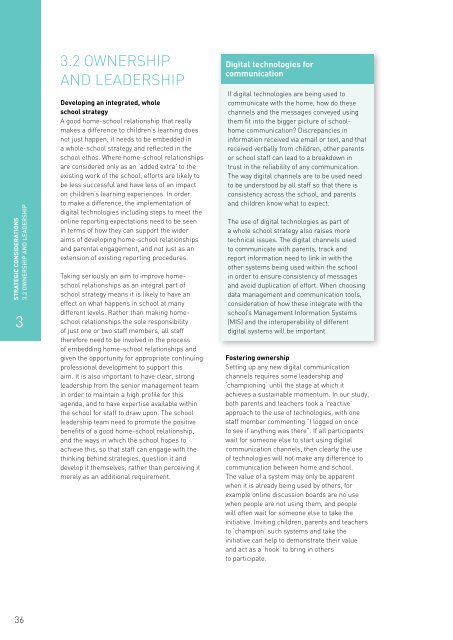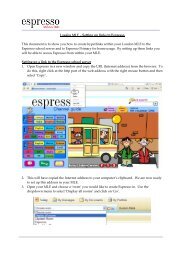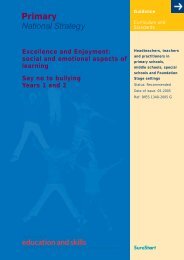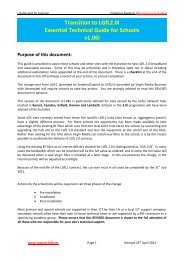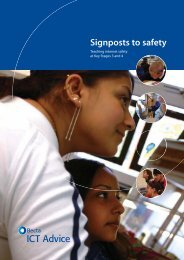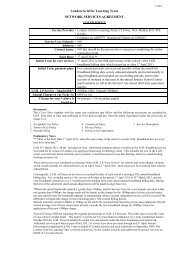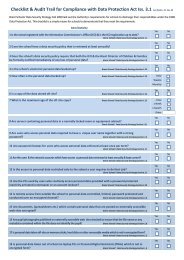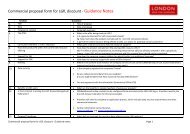Developing the home-school relationship using digital ... - Futurelab
Developing the home-school relationship using digital ... - Futurelab
Developing the home-school relationship using digital ... - Futurelab
- No tags were found...
You also want an ePaper? Increase the reach of your titles
YUMPU automatically turns print PDFs into web optimized ePapers that Google loves.
STRATEGIC CONSIDERATIONS3.2 OWNERSHIP AND LEADERSHIP33.2 OWNERSHIPAND LEADERSHIP<strong>Developing</strong> an integrated, whole<strong>school</strong> strategyA good <strong>home</strong>-<strong>school</strong> <strong>relationship</strong> that reallymakes a difference to children’s learning doesnot just happen; it needs to be embedded ina whole-<strong>school</strong> strategy and reflected in <strong>the</strong><strong>school</strong> ethos. Where <strong>home</strong>-<strong>school</strong> <strong>relationship</strong>sare considered only as an ‘added extra’ to <strong>the</strong>existing work of <strong>the</strong> <strong>school</strong>, efforts are likely tobe less successful and have less of an impacton children’s learning experiences. In orderto make a difference, <strong>the</strong> implementation of<strong>digital</strong> technologies including steps to meet <strong>the</strong>online reporting expectations need to be seenin terms of how <strong>the</strong>y can support <strong>the</strong> wideraims of developing <strong>home</strong>-<strong>school</strong> <strong>relationship</strong>sand parental engagement, and not just as anextension of existing reporting procedures.Taking seriously an aim to improve <strong>home</strong><strong>school</strong><strong>relationship</strong>s as an integral part of<strong>school</strong> strategy means it is likely to have aneffect on what happens in <strong>school</strong> at manydifferent levels. Ra<strong>the</strong>r than making <strong>home</strong><strong>school</strong><strong>relationship</strong>s <strong>the</strong> sole responsibilityof just one or two staff members, all staff<strong>the</strong>refore need to be involved in <strong>the</strong> processof embedding <strong>home</strong>-<strong>school</strong> <strong>relationship</strong>s andgiven <strong>the</strong> opportunity for appropriate continuingprofessional development to support thisaim. It is also important to have clear, strongleadership from <strong>the</strong> senior management teamin order to maintain a high profile for thisagenda, and to have expertise available within<strong>the</strong> <strong>school</strong> for staff to draw upon. The <strong>school</strong>leadership team need to promote <strong>the</strong> positivebenefits of a good <strong>home</strong>-<strong>school</strong> <strong>relationship</strong>,and <strong>the</strong> ways in which <strong>the</strong> <strong>school</strong> hopes toachieve this, so that staff can engage with <strong>the</strong>thinking behind strategies, question it anddevelop it <strong>the</strong>mselves, ra<strong>the</strong>r than perceiving itmerely as an additional requirement.Digital technologies forcommunicationIf <strong>digital</strong> technologies are being used tocommunicate with <strong>the</strong> <strong>home</strong>, how do <strong>the</strong>sechannels and <strong>the</strong> messages conveyed <strong>using</strong><strong>the</strong>m fit into <strong>the</strong> bigger picture of <strong>school</strong><strong>home</strong>communication? Discrepancies ininformation received via email or text, and thatreceived verbally from children, o<strong>the</strong>r parentsor <strong>school</strong> staff can lead to a breakdown intrust in <strong>the</strong> reliability of any communication.The way <strong>digital</strong> channels are to be used needto be understood by all staff so that <strong>the</strong>re isconsistency across <strong>the</strong> <strong>school</strong>, and parentsand children know what to expect.The use of <strong>digital</strong> technologies as part ofa whole <strong>school</strong> strategy also raises moretechnical issues. The <strong>digital</strong> channels usedto communicate with parents, track andreport information need to link in with <strong>the</strong>o<strong>the</strong>r systems being used within <strong>the</strong> <strong>school</strong>in order to ensure consistency of messagesand avoid duplication of effort. When choosingdata management and communication tools,consideration of how <strong>the</strong>se integrate with <strong>the</strong><strong>school</strong>’s Management Information Systems(MIS) and <strong>the</strong> interoperability of different<strong>digital</strong> systems will be important.Fostering ownershipSetting up any new <strong>digital</strong> communicationchannels requires some leadership and‘championing’ until <strong>the</strong> stage at which itachieves a sustainable momentum. In our study,both parents and teachers took a ‘reactive’approach to <strong>the</strong> use of technologies, with onestaff member commenting “I logged on onceto see if anything was <strong>the</strong>re”. If all participantswait for someone else to start <strong>using</strong> <strong>digital</strong>communication channels, <strong>the</strong>n clearly <strong>the</strong> useof technologies will not make any difference tocommunication between <strong>home</strong> and <strong>school</strong>.The value of a system may only be apparentwhen it is already being used by o<strong>the</strong>rs, forexample online discussion boards are no usewhen people are not <strong>using</strong> <strong>the</strong>m, and peoplewill often wait for someone else to take <strong>the</strong>initiative. Inviting children, parents and teachersto ‘champion’ such systems and take <strong>the</strong>initiative can help to demonstrate <strong>the</strong>ir valueand act as a ‘hook’ to bring in o<strong>the</strong>rsto participate.36


